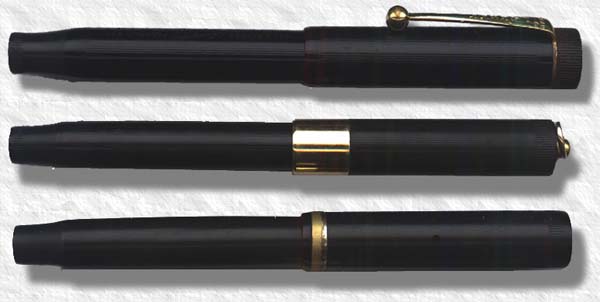
| parkerpens.net |
| PARKERCOLLECTOR.COM |
 |
Top: A 1925 Parker X in plastic, sans cap band with clip. Middle: A 1926 Parker Gold and Black, Lady style in plastic with a broad cap band and a ring top. Bottom: A 1924 black hard rubber Parker "DQ", Junior with one cap band, no clip. |
|
discontinued and two other models were introduced to capture the low-end markets. The Parkette and the Challenger. Both models featured in other colours than black. |
© 1995-2019 Tony Fischier and The Parker Pen Company®/Sanford Ecriture.
This page is in no way sponsored by or created by the Parker Pen Company®. All opinions, views, and thoughts expressed herein are expressly the authors, and in no way reflect the opinions, views, or thoughts of the Parker Pen Company®/Sanford Ecriture. All logos and/or images on these pages are © Copyright of Parker Pen Company®Sanford Ecritureunless otherwise stated and is reprinted by kind permission. If You feel that Your copyright has been violated please contact the WEBMASTER.
Everything on this website is copyrighted by law and can not be used without written permission from the author, Tony Fischier. You may however use the information as reference material and although it is forbidden to make digital copies or reproductions it may be physically printed for personal use, which does not include use on other web pages or in advertising. You may however quote parts of the content of this website, digitally or physically, providing that the source and author is clearly stated, together with the copyright information. In the US referred to as Fair use. If you use any information on this site, add a link.
Feel free to donate a small sum through Paypal to help this site to stay online. Acknowledgements.
Parkercollector.com in translated versions




 Parker Black and Gold pens. The lined barrels remained, collectors usually refer to all lined pens as the "DQ" ever though the later pens didn't have the additional imprint, "Black Line" is also used to describe the model. The new Black and Gold pens came in six sizes, three with cap bands and three without. the smallest had the #2 nib size.
Parker Black and Gold pens. The lined barrels remained, collectors usually refer to all lined pens as the "DQ" ever though the later pens didn't have the additional imprint, "Black Line" is also used to describe the model. The new Black and Gold pens came in six sizes, three with cap bands and three without. the smallest had the #2 nib size.